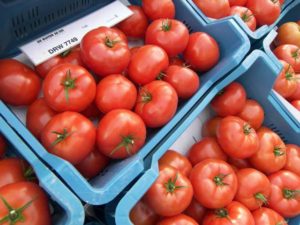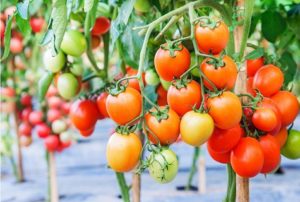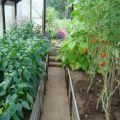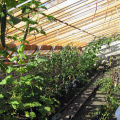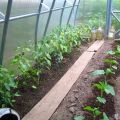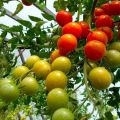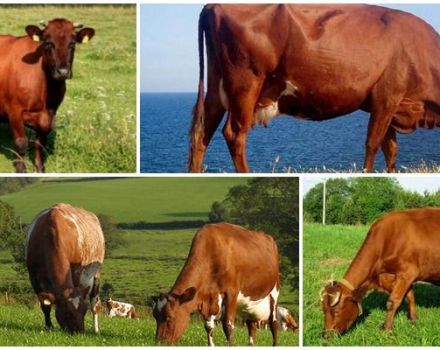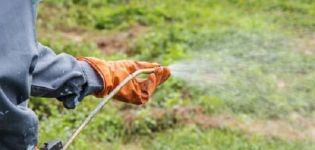Is it possible to plant peppers together or next to tomatoes in the same greenhouse or open field
A greenhouse is a unique place for any plant, where you can create the most convenient conditions for a good harvest. But is it possible to plant tomatoes and peppers in the same greenhouse, to combine the cultivation of separate crops under one roof? This question is of practical value for every gardener. It costs a lot of work, time and money to build the structure itself and provide conditions inside the greenhouse for the sake of one culture.
Why some vegetables don't get along well
Practical experience suggests that some vegetables do not work well together. At the micro level, processes invisible to us take place:
- Pollination. Closely related crops can exchange pollen. As a result, the crop can be unexpected. For example, it is not recommended to plant sweet peppers together with bitter ones. As practice shows, the bitter will win. That is, you will get one bitter pepper, there will be no sweet pepper in its pure form.
- Phytoncides. Vegetables not only consume trace elements and water from the soil, but also give back the so-called phytoncides. These are specific substances that determine the individual properties of each plant. Their purpose is to scare off pests and microorganisms. For example, if you sprout peppers next to fennel, then such a neighborhood can lead to the death of the crop. Fennel is very aggressive. Each plant seems to say to the rest of the inhabitants of the soil: "This is my territory, and I will fight for it."
- Evaporation to the environment. Probably many have noticed that each culture smells differently. This specific smell will not be able to mislead an experienced gardener. These are also phytoncides that can be felt next to tomatoes and which have as their purpose to scare away flying and crawling pests. The simultaneous function is to attract insects for pollination.
But how can pollen, fumes into the air and soil provoke oppression by some cultures of others? This effect is more pronounced when plants of different species interact. How can a culture that is adjacent to other plant species not affect another?
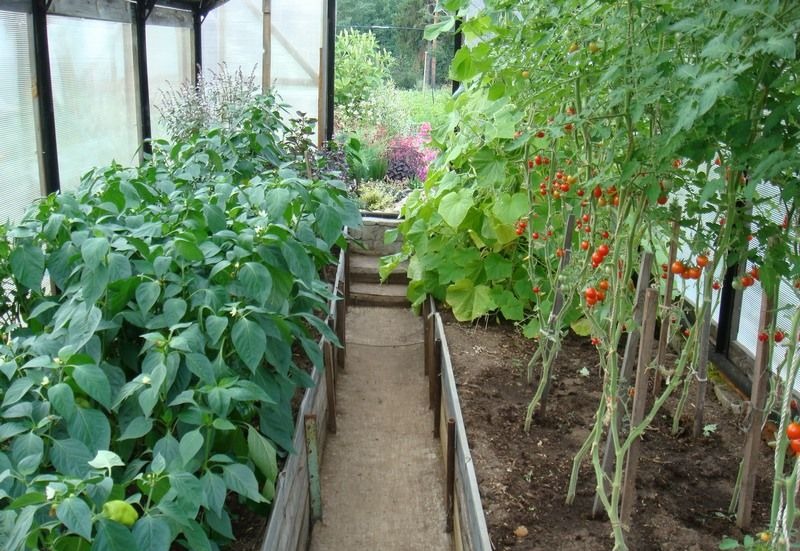
The answer to this question lies in the study of the rules of farming. Agricultural technology allows planting crops of the same species in the open field at a close distance. Their defense systems are similar and do not perceive each other as enemies. Tomatoes and peppers belong to the nightshade family and, as close relatives, will not conflict much.
What happens inside the greenhouse
In greenhouse conditions, we observe, in fact, an ideal picture of the content of vegetables:
- There is no weathering of the soil.
- Many pests and bacteria living in the open field have no access to this plant world.
- There are no natural factors such as wind, rain or hail, which are not uncommon in an open garden.
- Pollination does not occur with other inhabitants of the flora. In fact, the proximity to greenhouse vegetables does not affect other vegetables that live outside the greenhouse.
- High humidity.
- There are no sudden changes in temperature. We will not freeze tomatoes at night, the tomato will survive a smooth change in temperature, which happens in its natural environment, only in a milder form.
It turns out that in a greenhouse, tomatoes and peppers can only interact with each other. But since both cultures are not threatened by over-pollination, their neighborhood is conditional. Both crops belong to the nightshade family. All other factors are positive.
The mutual influence of tomatoes and peppers
And yet, if you grow tomatoes and peppers together, it is wise to take advantage of some advice from experienced vegetable growers:
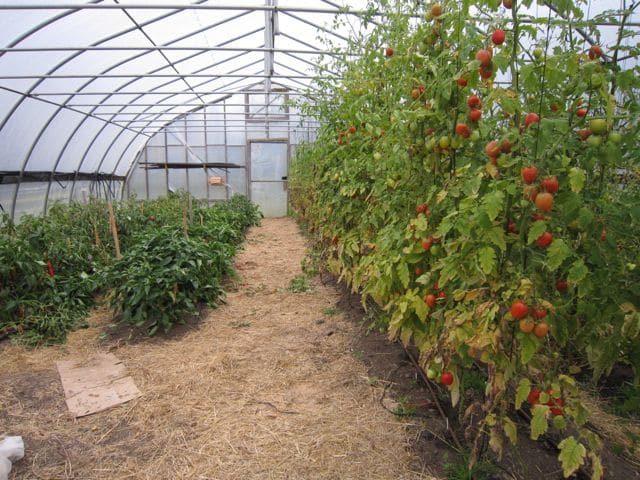
- The living conditions of the two crops are slightly different. Water after irrigation in the greenhouse evaporates and remains in the air. Tomatoes and peppers together like high water content in the air, but tomatoes need to be blown with air periodically.
- When planning plantings, it is necessary to plan red or bitter peppers closer to the walls of the greenhouse - there they will be warm and comfortable. Tomatoes need ventilation to provide airflow from the greenhouse entrance. It is most reasonable to plant them along the path from both ends.
- The distance between crops should be at least the width of two beds. Plants, of course, are related, but not so much. At close range, tomatoes and peppers will begin to clash through the root system and foliage, taking away water and trace elements from each other. We must not forget about phytoncides: plants will begin to fight with each other.
- But is it possible to plant several varieties of tomatoes or peppers in one greenhouse? This issue needs to be treated with extreme caution. Of course, the pepper will not pollinate the tomato and the tomato-pepper will not grow. But red and bitter peppers living in the same greenhouse will become friends, and as a result, both varieties will become bitter.
- What about planting different varieties of tomatoes in the same greenhouse? All nightshade crops are self-pollinated, so if you plant tomatoes of different varieties nearby, then this does not pose any danger to the population. Experienced gardeners specifically shake nightshade crops living in the same bed under one roof for better self-pollination: more ovaries appear and yield increases.
When growing super-elite varieties, it is not allowed to grow crops together from seeds of the first and second reproduction. This limitation includes peppers and tomatoes: these are related plants, and even the theoretical influence of crops on each other is excluded to obtain a super-pure product.
At the same time, the compatibility of pepper with pollination with other crops is zero. This rules out the hypothetical possibility of uncontrolled cross-pollination.
How to plan a greenhouse
The main question for vegetable growers is the maximum possible use of the area under crops in order to obtain good yields, the proximity to other crops somewhat complicates the achievement of this goal. In greenhouse conditions, this moment is of particular relevance. The conditions for keeping vegetables in a greenhouse environment are almost the same, and it is quite difficult to find a compromise in this matter.
When planting peppers with tomatoes in a greenhouse, you can follow a few simple tips:
- Plan the total area to be planted with the location of each crop.
- When planting peppers in the greenhouse begins, you can look at the agricultural calendar or be guided by your own experience. As already mentioned, growing peppers with tomatoes requires care when choosing a place for the latter.
- In order to differentiate as much as possible the conditions for keeping peppers in the greenhouse and tomatoes, you can stretch a plastic wrap between them.
Ventilation
In some cases, during the daytime, constant natural or forced ventilation is used throughout the area on which you plant tomatoes. But how to grow peppers in such a draft? During purging, individual beds are insulated with plastic wrap or sliding glazed covers. Green, red, Bulgarian or other varieties of peppers are only beneficial.
It is necessary to ventilate tomatoes periodically, the frequency depends on climatic conditions. When the first signs of phytocytosis (fungal disease) appear, the purge rate or its frequency must be increased. It is useful to carry out preventive spraying with an antiseptic solution once a month. The greenhouse is closed at night: this will keep the temperature, humidity and prevent the flow of cold air.
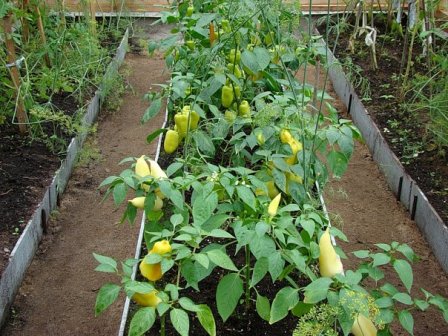
Sometimes it becomes necessary to warm up the greenhouse with a stream of warm air. This happens under extreme weather conditions. In some areas, other other crops next to the pepper in the greenhouse are planted to obtain early seedlings. Usually in these cases, one or more heat guns are used with a maximum output temperature of no higher than 40 degrees.
Peppers and tomatoes in the same greenhouse are located on the sides of the path, which is always wider than the row spacing. The warm air flow is directed towards the center of the greenhouse.
Lighting
Sometimes gardeners go even further and organize special lighting with monochrome radiation of a certain frequency. But can you grow two nightshade crops with additional lighting? It turns out that in this case the plant preferences are the same.
When vegetables are irradiated with special light, all vital processes in plants are accelerated.
It turns out that tomatoes next to peppers are equally good at accelerating their growth and increasing yields. The attraction to the light of plants is known to all gardeners, but, as it turned out, for the normal development of culture, lighting of a certain spectrum is necessary.
If we grow tomatoes and peppers in the same greenhouse, then for these crops two points can be distinguished related to additional lighting:

- The red and blue spectrum will help stems and leaves grow.
- Green light will cause intense fruit growth.
The processes of photosynthesis in plants are directly dependent on lighting. In the dark, crops die, but under normal lighting they grow well. Lack of light causes such negative effects:
- Thinning of the stem.
- Changes in plant color. The stems and leaves will turn pale green and lose their rich color.
- The sprouts stretch out in search of light, the seedlings become weak and do not take root well.
Competent use of agricultural experience in private farming is a guaranteed result of a good harvest. Studying nature, you can learn not only about whether tomatoes and peppers can be planted in the same greenhouse, but also a lot of informative things about plant life.
